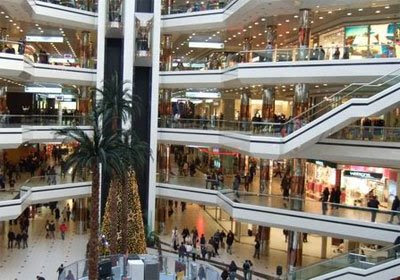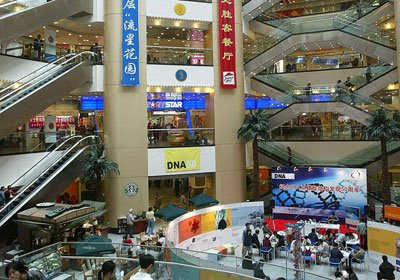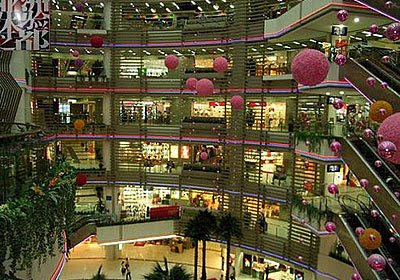The World Largest Malls
>> Monday, March 29, 2010
They're springing up in Asia, but will they all last?
Heading out to the mall--isn't that yesterday's way to shop?
Not in Asia, where land is cheap and labor costs are low. A building boom has enormous shopping malls popping up in China, Malaysia and the Philippines, with India expected to jump into the fold soon. Based on gross leasable area, or the amount of space devoted to revenue-producing operations like stores, amusements and food, the continent is home to nine of the world's 10 largest malls, six of which have been built since 2004. That's added some 27 million square feet of shopping space to cities like Beijing and Guangzhou in China and Kuala Lumpur in Malaysia.
While many traditional malls in North America are getting squeezed by a big-box era that includes the likes of Wal-Mart Stores (nyse: WMT - news - people ), Best Buy (nyse: BBY - news - people ) and Target (nyse: TGT - news - people ) in nearly every county, Asia's rapidly growing economy has spawned a new wave of consumers looking for places to shop and play.
In Pictures: The World's 10 Largest Shopping Malls
Most of them are quite ritzy, too. A pair of Chinese malls that rank as the world's two largest--the South China Mall in Dongguan and Golden Resources Mall in Beijing--include features like wind mills and kids' theme parks. Golden Resources Mall is surrounded by newly built apartments and office buildings.
Just four years ago, the top 10 list would have included a pair of popular California destinations--South Coast Plaza in Costa Mesa and Del Amo Fashion Center in Los Angeles--along with the King of Prussia Mall in Pennsylvania and the famed Mall of America in Bloomington, Minn.
"It's almost unimaginable, the boom that has occurred in these Eastern cities," says Emil Pocock, a professor at Eastern Connecticut State University, whose American Studies department has documented the sizes and amenities of the world's largest malls. Many more of those regions' consumers now own cars, he notes, a phenomenon that has stimulated demand for more destination shopping centers. That's attracted money from mall-management groups from outside the country, largely from Indonesia and Japan.
"These people need a place to shop, and it's not going to be at the old shopping districts that date back to the days of traditional socialist rule," Pocock says.
There's a downside to all this building in China, at least in the short term. With many residents still accustomed to shopping in small local shops, demand isn't yet keeping up with supply at the new, big malls, according to information supplied to Eastern Connecticut State by Steven Beesley, co-founder of the Institute of Shopping Centre Management in Hong Kong. Malls built outside the downtown areas of major metros could have trouble surviving, he thinks.
In the U.S., meanwhile, the traditional shopping mall is part of a saturated market, thanks to the off-mall big-box retailers and to retail-industry consolidation that has jettisoned previously popular anchor stores like Montgomery Ward from the landscape. Many malls have taken to revamping or downsizing to survive. At the Houston Mall in Texas, for example, a traffic court and outpatient health-care services have replaced big stores like Sears.
And at Illinois' Park Forest Mall, near Chicago, Sears and other big stores were razed about 10 years ago to make way for a Main Street thoroughfare that includes a town green, residential units and a series of smaller stores.
In the hope of finding future growth, developers are turning to mixed-use centers, projects that combine retail, dining, entertainment and residential living units, not unlike some of the new Asian malls, like the Beijing Mall and Berjaya Times Square in Malaysia.
"We recognized in the '90s that the future of the business would be acquiring properties and [enhancing] them," says John Bucksbaum, chief executive of General Growth Properties (nyse: GGP - news - people ).
An acquisition spree begun in 1993 has increased his company's portfolio of shopping-center properties to over 200, with a market capitalization of approximately $37 billion, from 22 centers and a $1.2 billion market cap. An ambitious project that sums up GGP's vision is a massive redevelopment of the Natick Mall, a 40-year-old shopping center in suburban Boston. Longtime anchors Macy's (nyse: M - news - people ) and Sears aren't going anywhere, but a major expansion will add two luxury condominium complexes and an upscale shopping area headlined by Neiman Marcus and Nordstrom (nyse: JWN - news - people ).
Elsewhere, mixed-use "lifestyle centers," a creation of outdoor urban villages that mix retail theater and condos, are lining the map more and more. At Biltmore Fashion Park in Phoenix, outdoor walkways, myriad restaurants and spas surround top retail names like Neiman Marcus and Gucci. And at The Oaks, originally a 1970s-era mall in Thousand Oaks, Calif., near Los Angeles, a 1993 makeover helped it fit in with a planned suburb that includes growth areas like Simi Valley, Camarillo and Agoura Hills.
If the trend holds, say goodbye to the store-dominated mall, one where weary shoppers looking for a dining or amusement break are limited to the food court and the arcade room.
"It creates more density on the land you already own, which a lot of communities prefer to urban sprawl," Bucksbaum says.
No : 1 South China Mall
Location: Dongguan, China
Year Opened: 2005
Gross Leasable Area: 7.1 million square feet
In the Chinese mall arms race, this facility opened a year after the Golden Resources Mall to displace it as the country's and the world's largest. The space includes wind mills and theme parks, plus a replica of the Arc de Triomphe.
Heading out to the mall--isn't that yesterday's way to shop?
Not in Asia, where land is cheap and labor costs are low. A building boom has enormous shopping malls popping up in China, Malaysia and the Philippines, with India expected to jump into the fold soon. Based on gross leasable area, or the amount of space devoted to revenue-producing operations like stores, amusements and food, the continent is home to nine of the world's 10 largest malls, six of which have been built since 2004. That's added some 27 million square feet of shopping space to cities like Beijing and Guangzhou in China and Kuala Lumpur in Malaysia.
While many traditional malls in North America are getting squeezed by a big-box era that includes the likes of Wal-Mart Stores (nyse: WMT - news - people ), Best Buy (nyse: BBY - news - people ) and Target (nyse: TGT - news - people ) in nearly every county, Asia's rapidly growing economy has spawned a new wave of consumers looking for places to shop and play.
In Pictures: The World's 10 Largest Shopping Malls
Most of them are quite ritzy, too. A pair of Chinese malls that rank as the world's two largest--the South China Mall in Dongguan and Golden Resources Mall in Beijing--include features like wind mills and kids' theme parks. Golden Resources Mall is surrounded by newly built apartments and office buildings.
Just four years ago, the top 10 list would have included a pair of popular California destinations--South Coast Plaza in Costa Mesa and Del Amo Fashion Center in Los Angeles--along with the King of Prussia Mall in Pennsylvania and the famed Mall of America in Bloomington, Minn.
"It's almost unimaginable, the boom that has occurred in these Eastern cities," says Emil Pocock, a professor at Eastern Connecticut State University, whose American Studies department has documented the sizes and amenities of the world's largest malls. Many more of those regions' consumers now own cars, he notes, a phenomenon that has stimulated demand for more destination shopping centers. That's attracted money from mall-management groups from outside the country, largely from Indonesia and Japan.
"These people need a place to shop, and it's not going to be at the old shopping districts that date back to the days of traditional socialist rule," Pocock says.
There's a downside to all this building in China, at least in the short term. With many residents still accustomed to shopping in small local shops, demand isn't yet keeping up with supply at the new, big malls, according to information supplied to Eastern Connecticut State by Steven Beesley, co-founder of the Institute of Shopping Centre Management in Hong Kong. Malls built outside the downtown areas of major metros could have trouble surviving, he thinks.
In the U.S., meanwhile, the traditional shopping mall is part of a saturated market, thanks to the off-mall big-box retailers and to retail-industry consolidation that has jettisoned previously popular anchor stores like Montgomery Ward from the landscape. Many malls have taken to revamping or downsizing to survive. At the Houston Mall in Texas, for example, a traffic court and outpatient health-care services have replaced big stores like Sears.
And at Illinois' Park Forest Mall, near Chicago, Sears and other big stores were razed about 10 years ago to make way for a Main Street thoroughfare that includes a town green, residential units and a series of smaller stores.
In the hope of finding future growth, developers are turning to mixed-use centers, projects that combine retail, dining, entertainment and residential living units, not unlike some of the new Asian malls, like the Beijing Mall and Berjaya Times Square in Malaysia.
"We recognized in the '90s that the future of the business would be acquiring properties and [enhancing] them," says John Bucksbaum, chief executive of General Growth Properties (nyse: GGP - news - people ).
An acquisition spree begun in 1993 has increased his company's portfolio of shopping-center properties to over 200, with a market capitalization of approximately $37 billion, from 22 centers and a $1.2 billion market cap. An ambitious project that sums up GGP's vision is a massive redevelopment of the Natick Mall, a 40-year-old shopping center in suburban Boston. Longtime anchors Macy's (nyse: M - news - people ) and Sears aren't going anywhere, but a major expansion will add two luxury condominium complexes and an upscale shopping area headlined by Neiman Marcus and Nordstrom (nyse: JWN - news - people ).
Elsewhere, mixed-use "lifestyle centers," a creation of outdoor urban villages that mix retail theater and condos, are lining the map more and more. At Biltmore Fashion Park in Phoenix, outdoor walkways, myriad restaurants and spas surround top retail names like Neiman Marcus and Gucci. And at The Oaks, originally a 1970s-era mall in Thousand Oaks, Calif., near Los Angeles, a 1993 makeover helped it fit in with a planned suburb that includes growth areas like Simi Valley, Camarillo and Agoura Hills.
If the trend holds, say goodbye to the store-dominated mall, one where weary shoppers looking for a dining or amusement break are limited to the food court and the arcade room.
"It creates more density on the land you already own, which a lot of communities prefer to urban sprawl," Bucksbaum says.
No : 1 South China Mall
Location: Dongguan, China
Year Opened: 2005
Gross Leasable Area: 7.1 million square feet
In the Chinese mall arms race, this facility opened a year after the Golden Resources Mall to displace it as the country's and the world's largest. The space includes wind mills and theme parks, plus a replica of the Arc de Triomphe.
No : 2 Golden Resources Shopping Mall
Location: Beijing, China
Year Opened: 2004
Gross Leasable Area: 6 million square feet
Not sprawling, this is a stacked-up five-story mall. Approximately 1,000 stores, selling plenty of familiar global brands like Nike and DKNY. A truly ambitious real estate project, with new apartments and offices, surround the mall. A tough location outside the heart of the city has resulted in disappointing traffic from foreign tourists.
No : 3 SM Mall of Asia
Location: Pasay City, Philippines
Year Opened: 2006
Gross Leasable Area: 4.2 million square feet
Includes the first Olympic-sized swimming pool and first IMAX theater in the Philippines. Spread over four buildings, customers can get around on a 20-seat tram.
No : 4 Cevahir Istanbul
Location: Istanbul, Turkey
Year Opened: 2005
Gross Leasable Area: 3.8 million square feet
Europe's largest shopping mall has a roller coaster, wave pool and several IMAX theaters.
No : 5 West Edmonton Mall
Location: Edmonton, Alberta, Canada
Year Opened: 1981
Gross Leasable Area: 3.8 million square feet
The biggest in North America, the West Edmonton Mall has over 800 stores, along with attractions like a water park, skating rink, casino and rides.
No : 6 SM Megamall
Location: Mandaluyong City, Philippines
Year Opened: 1991
Gross Leasable Area: 3.6 million square feet
Fun stuff includes bowling, ice skating and a 12-cinema movie theater, along with traditional mall fare like arcade games. Customers can also get a haircut or see a doctor at the Manila clinic.
No : 7 Berjaya Times Square
Location: Kuala Lumpur, Malaysia
Year Opened: 2005
Gross Leasable Area: 3.4 million square feet
Built with an adjacent hotel and convention center. In addition to over 1,000 retail shops, the mall includes a 12-story-high roller coaster, plus a pool, skating rink and "Cosmo's World," a children's theme park.
No : 8 Beijing Mall
Location: Beijing, China
Year Opened: 2005
Gross Leasable Area: 3.4 million square feet
The first real suburban mall in China, located about an hour from downtown Beijing, this center has four levels with parking for 8,000 cars, plus a man-made beach. Bootlegged DVDs of American movies are a top seller.
No : 9 Zhengjia Plaza
Location: Guangzhou, China
Year Opened: 2005
Gross Leasable Area: 3 million square feet
Has been known to attract over half a million shoppers on a good day. Another mixed-use space, the mall has a hotel and office tower in addition to retail stores.
No : 10 SM City North Edsa
Location: Quezon City, Philippines
Year Opened: 1985
Gross Leasable Area: 3 million square feet
The first major "mega mall" built by SM Prime Holdings, which now claims three of the largest 10 in the world. It's a five-story complex that boasts over 100 retail outlets and restaurants, along with 12 cinemas, a bowling alley and skating rink. An IMAX theater could be added soon.











